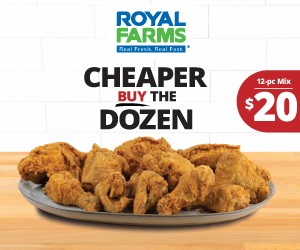(Photo courtesy of Clemson University)
OWINGS MILLS, Md. — Finding the sweet spot between talent and need is the key to winning the NFL draft over the long haul.
It’s something the Ravens have done better than most teams and a significant reason why they’ve been a model franchise over the last quarter-century. They’re counting on Clemson’s Nate Wiggins becoming the latest success story as the speedy 6-foot-1, 182-pound defensive back was the fifth cornerback to be selected in the first round in team history, joining Duane Starks (1998), Chris McAlister (1999), Jimmy Smith (2011), and Marlon Humphrey (2017). That’s impressive company with Starks being the only one not to receive a second contract with Baltimore, and that decision was driven more by a prohibitive 2002 salary cap than his play, which was superb in winning Super Bowl XXXV.
Addressing an offensive line that subtracted three starters from last year’s 13-4 team was the Ravens’ greatest need entering the draft and still is entering Day 2. But you didn’t have to be a draft expert to see the board had been picked clean of the consensus first-round talents by the time Baltimore was on the clock at 30th overall late Thursday night, and general manager Eric DeCosta reiterated the organization’s stance on not trading up with few exceptions, maintaining that “your chances to really maximize your draft are to stay where you are or go back.”
Reaching for an offensive tackle with a second-round grade wouldn’t have been the best value with the 30th pick, but drafting a highly regarded cornerback who addressed a significant depth need and carried long-term starter potential made perfect sense. Also interested in adding to their wide receiver room over the weekend, the Ravens didn’t appear keen on drafting one in the first round for the fourth time in six years, a feeling reinforced by extending 2021 first-round pick Rashod Bateman’s contract this week.
“That’s something that honestly kept me up at night just because there are a lot of offensive linemen in this draft, [and] there is a pretty good pool of receivers,” DeCosta said. “But as I would go through and work on all these different simulations, it became apparent that if we didn’t get a corner in the first round, it was going to be challenging to get a really good corner in the second round, third round, fourth round who could help us right away. Not to say we wouldn’t have taken a receiver; we would have [or] we would have taken an offensive lineman.
“But for us, if you’re talking about all the different combinations how we can be the best team we can be, I think just getting a corner at this point like Nate is probably the best way we could have started this weekend.”
Time will tell whether Wiggins — who doesn’t turn 21 until August and still needs to mature some physically — was the better choice over the more versatile Cooper DeJean out of Iowa or Alabama’s Kool-Aid McKinstry, but the Ravens had selected only one cornerback over the first two days of their last six drafts, meaning a meaningful pick investment at such a premium position was overdue. Not only did Baltimore lack established outside depth behind its starting corners following the free-agent departure of Ronald Darby, but Humphrey is coming off an injury-plagued 2023 and scheduled to carry the second-highest salary cap number on the team over the next three years while Stephens is entering a contract season.
Head coach John Harbaugh said he imagined the possibility of Wiggins falling to the Ravens at the start of the evening before insisting it would “never happen.” Meanwhile, DeCosta said Clemson head coach Dabo Swinney was texting the team’s brass imploring them to pick the first-team All-ACC cornerback. Adding a third starting-caliber outside corner allows new defensive coordinator Zach Orr to more easily move pieces around in the secondary, something predecessor Mike Macdonald did with great success over the last two years.
“Marlon’s going to be able to slide in there and play inside,” Harbaugh said. “Brandon can slide in and play inside. You have Kyle [Hamilton] coming down [from safety]. You have Kyle going over and playing dime backer possibly. We’re just going to have a lot of options. Zach’s going to be working on that versatility probably tonight.”
Of course, we’ll see how the next couple rounds unfold in the quest to improve the offensive line. While the nine teams who selected offensive linemen in the first round now appear less likely to target that position group, there’s no guarantee the second and third rounds won’t play out in a similar fashion to the first round when even the likes of Oklahoma’s Tyler Guyton and Arizona’s Jordan Morgan were off the board by the time the Ravens picked.
The best draft classes are a cross section of talent and need, and the Ravens seem thrilled with their first puzzle piece of the weekend.
“I’ve got to give [manager of data and decision science] Derrick Yam credit. Derrick works for me upstairs in analytics,” DeCosta said. “He does a great job with modeling and different things, and he was convinced that we would get a player in our range between [pick] 13 and 20 in our sequence — we’re picking 30. I didn’t think it was going to happen this year, but he was right.
“When you get a player that you have highly rated, who you love, who fills a position of need, then you’ve got to take him.”





























